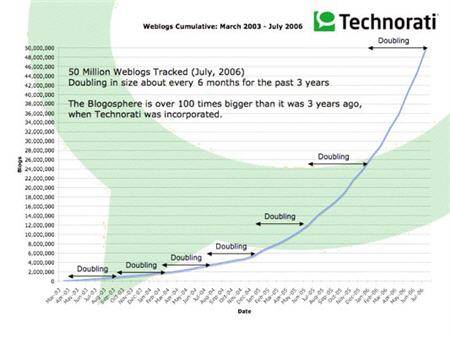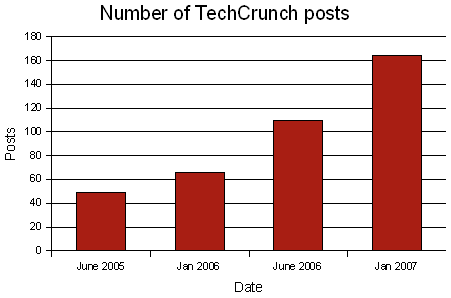Written by Alex Iskold and edited by Richard MacManus
It is no secret that we live in an information overload age. The explosion of new types of information online is a double-edged sword. We both enjoy and drown in news, blogs, podcasts, photos, videos and cool MySpace pages. And the problem is only going to get worse, as more and more people discover the new web. Consider the two charts below, illustrating the growth of the Blogosphere at large and also in number of posts published by tech news blog TechCrunch:


Because of this information explosion, we no longer read – we skim. The news that used to last a day now lasts just a few hours, simply because we need to pay attention to the new news. So it is becoming increasingly difficult to juggle all the news sources and keep on top of things. Which brings us to the law of information, stated first by Herbert Simon: the rapid growth of information causes scarcity of attention.
Economics of Attention
Things get more interesting when we realize that our attention crisis is not only our problem. It is also a big problem for news sites, blogs, search engines and online retailers. Our scarcity of attention hurts their economics. The web sites that contain content relevant to us have a big incentive to make sure that we find it. Consider this scenario. You navigate to a news site and start reading the headlines. What is the likelihood that you leave if you see an irrelevant headline? High. Another example. You go to Netflix and look at movie recommendations. What is the likelihood that you will stop browsing after Netflix shows you a movie you do not like? Again, very high.
When information is abundant, the false positives are very costly – they are basically deal breakers. Consumers happily leave sites, knowing there are a ton of alternatives out there. Unfortunately, this becomes a lose-lose situation, because if consumers rarely find satisfying experiences then retailers won’t get consumer dollars. The idea behind the Attention Economy is to create a marketplace where consumers are happy, because if they are shown relevant information – then retailers are happy too, because happy consumers spend money!
Attention Economy Concepts
The basic ideas behind the Attention Economy are simple. Such an economy facilitates a marketplace where consumers agree to receives services in exchange for their attention. The ultimate purpose is of course to sell something to the consumer, but the selling does not need to be direct and does not need to be instant. For example news feeds illustrate the point well, since they ask for consumers attention in exchange for the opportunity to show him/her advertising. The Search engines are similar in that respect, because they show ads in exchange for helping users find answers online.
It is important to realize that the key ingredient in the attention game is relevancy. As long as a consumer sees relevant content, he/she is going to stick around – and that creates more opportunities to sell. Literally, the longer a user stays on a site reading news etc, the higher the chance that person will click on an ad. So the question is: how do you show the user relevant content? This is a complex problem that can be partially addressed by recommendation engines. However, it is not possible for sites to generate relevant, personalized content unless they know the user. To personalize, web sites need to know you: your browsing history, the books you like, the wines you drink, the music you listening to, etc. The more information the better.
Another key ingredient of the Attention Economy is privacy. The challenge is not just to protect consumers information, the challenge is to put the user in control of her information. The notion that in an Attention Economy, a user’s information is up for grabs and can be bought and sold is misinformed. Instead, the user chooses what services he/she wants to receive, in exchange for their attention information. To help message these ideas and to protect consumers, Steve Gillmor and Seth Goldstein founded an organization called AttentionTrust.
AttentionTrust

Something as big as an Attention Economy needs a solid foundation. This marketplace needs participants who play by the rules, as defined by an independent entity. The founders of AttentionTrust succeeded in defining a simple, elegant, yet encompassing set of principles that define the rules of the game, by outlining the basic consumer rights in the AttentionEconomy:
- Property: You own your attention and can store it wherever you wish. You have CONTROL.
- Mobility: You can securely move your attention wherever you want, whenever you want to. You have the ability to TRANSFER your attention.
- Economy: You can pay attention to whomever you wish and receive value in return. Your attention has WORTH.
- Transparency: You can see exactly how your attention is being used.
So the principles define the rules for any company that wishes to participate in the Attention Economy. For example, it follows from the rules that services should provide a way for users to export their information. Another consequence of the rules is that a user should be able to request cancellation of their account and deletion of all their information. So these seemingly simple rules ensure that participants transact fairly and that businesses do not monopolize users information.
Technology of Attention
The concept and principles of the Attention Economy sound appealing, but they beg a question: is all of this feasible? Clearly many things need to fall into place for something as big as this to be born. Technology and the architecture of attention play an important role in facilitation of the marketplace. Ideally, a body of standards and protocols should be the technological foundation of the Attention Economy. Since these are early days of the conversation about attention, such standards do not yet exist. Here is an outline of what the Attention Architecture will look like (there is a detailed post on the topic from last year on my personal blog):
According to the diagram above, both implicit (clickstream) and explicit (bookmarks) attention is captured and stored in a database. The users have control over what attention capturing system to use. For example, AttentionTrust has created a Firefox add-on called AttentionRecorder which captures clickstream and redirects to a vault. The user also has a choice of where to store the data. A standard protocol between the attention capturing software and storage software ensures that users have the choice.
The user information that is stored in the database can be accessed by trusted services. These services, approved by the user in advance, have the opportunity to take advantage of the user information to deliver personalization. For example, Netflix can take advantage of the user data to personalize movie recommendations. Newsvine can use the user’s OPML to personalize news and Google can use the data to prioritize and filter their search results. So from a technical point of view, the key to facilitating the attention marketplace is in decoupling of attention capturing, attention storage and attention recording services.
Challenges ahead
Despite a large number of issues and substantial complexity, the Attention Economy is coming. The economics of the web and information explosion are driving us towards it. Understanding the issues and laying down correct principles and technology are important, to ensure this future marketplace is healthy. Here are some of the important issues that need to be addressed:
- Silos: User information needs to be freed from proprietary silos
- Round Table: The industry needs to create a round table, to enable organizations to govern both the business and technical aspects of the attention economy (think Java Community Process).
- Education: People need to be educated about the value of their attention and the principles of attention economy. Avoiding privacy concerns will not work, instead they need to be tackled head on.
These challenges are far from trivial and will take time to resolve. Particularly, an industry round table is critical in order to expedite creation of standards and infrastructure for attention. The initiatives in several large web companies are on the way, but nothing has been formally announced. Also, a lot of smaller companies are well on the way to building attention services. They do not yet plug into a marketplace, but they will once the appropriate body of standards emerges.
So this is the current state of the ‘attention’ space. Please let us know how you think this will evolve and which are your favorite attention companies. Also let us know if you are interested in more posts on the topic.










